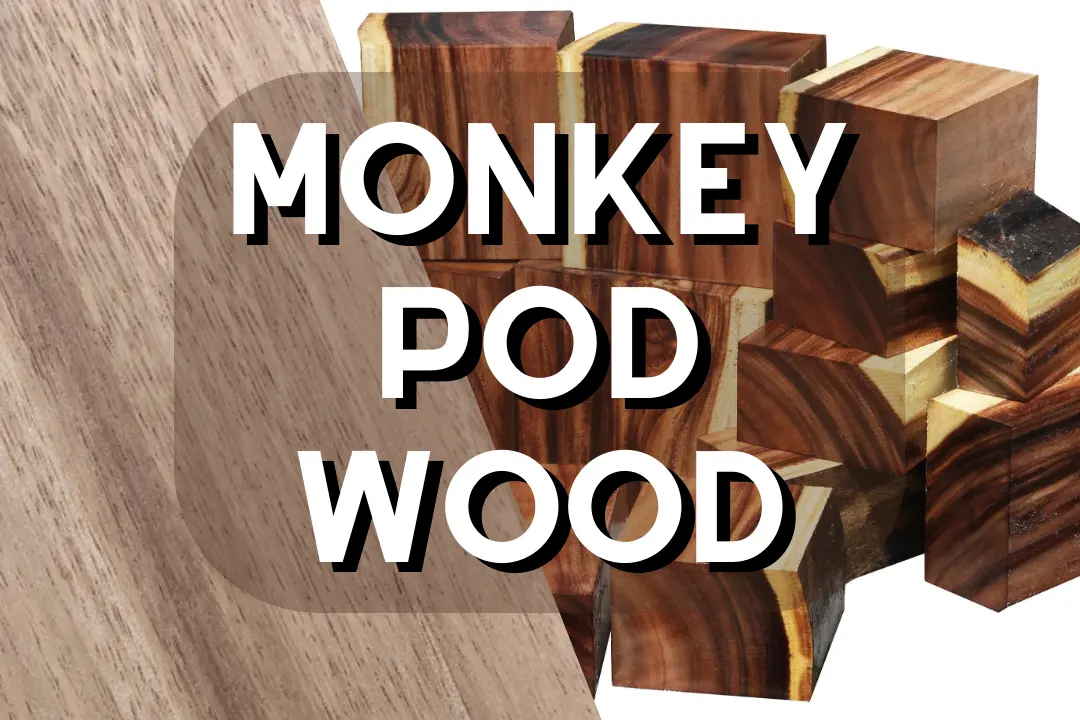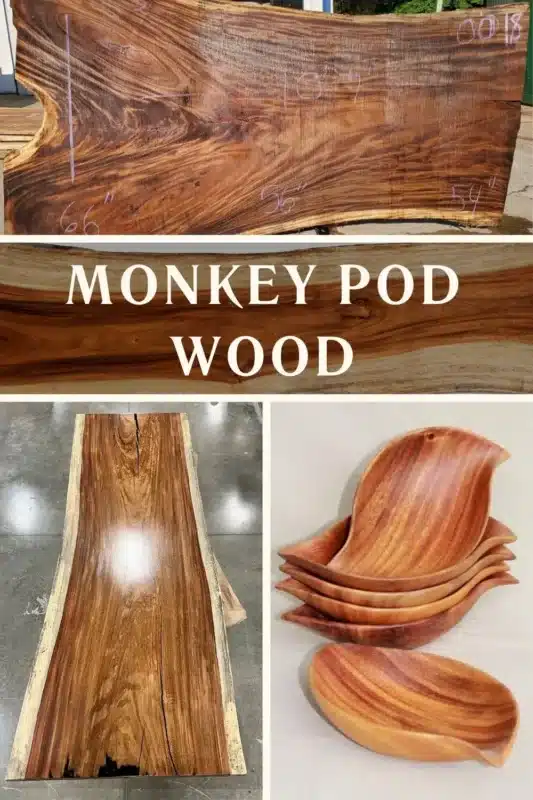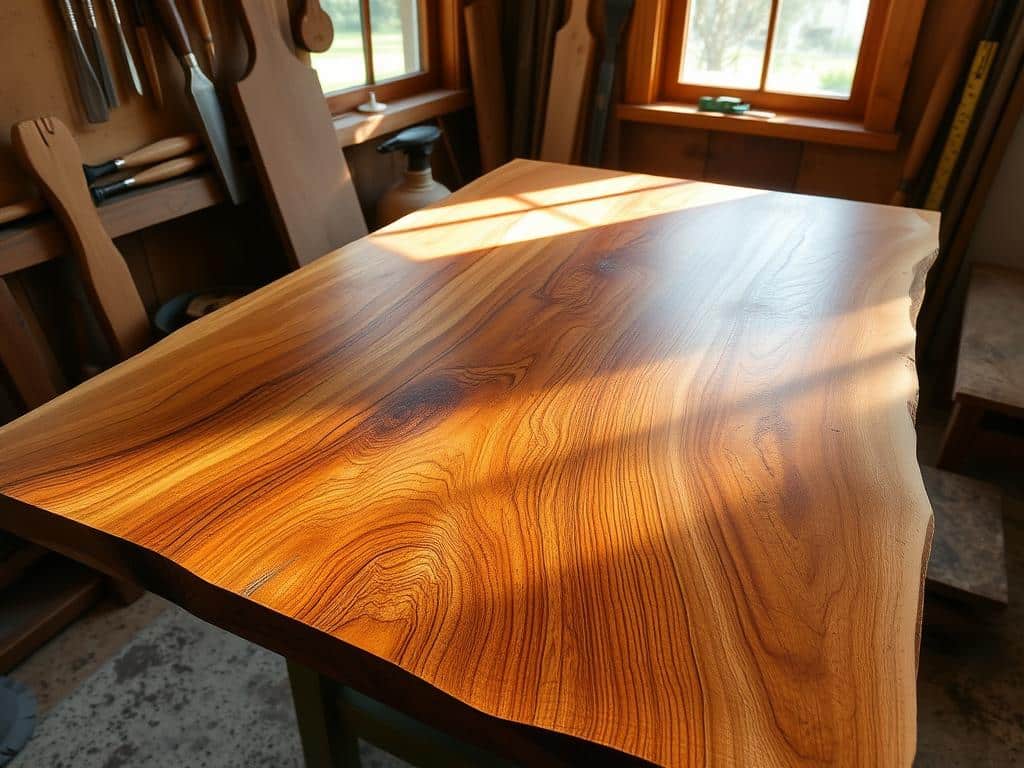
Why Monkey Pod Wood Is Loved by Experts Worldwide

Did you know that over 70% of woodworkers globally choose monkey pod wood? Its unique look, durability, and eco-friendliness are key reasons. Sourced from the Pithecellobium saman tree, it’s a favorite among artisans and furniture designers.
This tropical wood is not just beautiful but also stable. It’s perfect for many woodworking projects. As more woodworkers focus on sustainability, monkey pod wood stands out. It’s abundant in Central and South America, making it a great choice for eco-friendly projects.
Experts worldwide love it for its beauty and its role in protecting the environment. It’s a wood that looks great and is good for the planet.
Table of Contents
Tropical Beauty of Monkey Pod Wood
Monkey pod wood is truly stunning. Its color changes are amazing, attracting both fans and makers. It has golden to reddish-brown shades, giving it a majestic look like mahogany but with a tropical twist.
Color Variations and Appearance
Monkey pod wood comes in a wide range of colors. It smoothly moves from light to dark, with creamy white sapwood contrasting with the deeper colors. This mix makes it perfect for many uses, like furniture and decorations.
Unique Grain Patterns
The grain patterns of this decorative wood are fascinating. Many pieces have interlocked or “rowed” textures, creating unique surfaces. Dark streaks and curls add to the wood’s natural beauty, making each piece special.
Origins of the Monkey Pod Tree
The monkey pod tree, known scientifically as Pithecellobium saman, has a fascinating history. It shows its adaptability and ecological importance. Native to Central and South America, it grows from Mexico to Brazil, thriving in diverse tropical climates.
Its journey from a native species to a widely cultivated tree is interesting. This shows how it has spread across the world.
Native Regions and Environmental Benefits
Monkey pod trees grow best in certain latitudes. They need annual rainfall of 640 mm to 3810 mm (25 to 150 inches). In Hawaii, introduced in 1847, they do well in wet winters.
They can grow up to 700 meters (2,300 feet) high. They provide shade and shelter, helping local ecosystems. The trees help absorb rainfall and prevent soil erosion, boosting biodiversity.
Historical Significance of the Monkey Pod Tree
Monkey pod trees have been valuable in many cultures. In Hawaiian traditions, they were a key resource for artisans. Their wood is both beautiful and practical, used for furniture and sculptures.
The first monkey pod trees in Hawaii were planted with just two seeds. One famous tree, the “Mark Twain” tree, became a local legend before it died in 1957. Its story highlights the tree’s resilience and community ties.
Monkey Pod Wood in Woodworking
Monkey pod wood is a top pick for woodworking. It looks great and lasts long. Woodworkers worldwide love it for its beauty and strength.
Popular Uses and Applications
This wood is great for making:
- Furniture, like tables and chairs
- Cabinets
- Turned crafts
- Musical instruments
- Decorative items and gifts
The wood’s grain and color make it special. Boards are 4 to 24 inches wide and 8 to 12 feet long. This lets woodworkers get creative.
Durability and Stability Characteristics
This tropical hardwood is very durable. It doesn’t rot or get damaged by insects. It stays stable indoors and outdoors.
It’s as heavy and hard as cherry but has a coarser grain. The sapwood is creamy white, and the heartwood is reddish-brown. This makes it look even better.
But working with it can be tricky. Handplaning can tear the wood. Power carving and sanding work better. Despite this, more people want to use this unique wood.
| Characteristic | Details |
|---|---|
| Typical Width | 4 to 24 inches |
| Typical Length | 8 to 12 feet |
| Price per Board Foot | $16 to $20 |
| Resistance to Damage | Rot and insect damage |
| Weight and Hardness | Similar to cherry; coarser grain |
| Suitable Finishing Methods | Table saw, sander, power carving |
Working Properties of Monkey Pod Wood
Working with monkey pod wood is both challenging and rewarding. It’s durable and easy to cut, but its grain can make finishing tricky. This wood is known for its beauty and strength.
Challenges in Cutting and Finishing
Monkey pod wood is hard, making it easy to work with. But finishing it requires careful planning. The grain can cause fuzzy or torn surfaces when planed.
Using sharp tools and sanding carefully can help. This way, the wood can get a smooth finish. A smooth finish is key for quality woodworking.
Comparison with Other Woods
This golden-brown hardwood is similar to cherry and mahogany in some ways. It has a Janka hardness of 900 lbf, like cherry. This makes it easy for woodworkers who work with cherry to adapt.
But, its coarser grain is different from mahogany’s smoothness. Knowing these differences helps woodworkers choose the right wood for their projects. It shows what makes monkey pod wood special.

Monkey Pod Wood’s Role in Hawaiian Culture
Monkey pod wood is deeply connected to Hawaiian culture. It’s used in many traditional crafts and artistic expressions. This wood, taken from nature, is a key material for Hawaiian artisans. It shows the island’s beauty and its cultural importance.
Use in Traditional Crafts and Art
Monkey pod wood is used to make unique handcrafted items. These include:
- Decorative bowls
- Tiki carvings
- Musical instruments
- Furniture with intricate designs
The wood’s natural warmth and striking grain make it a favorite for local craftsmen. Over time, artisans have learned to turn monkey pod into beautiful pieces. These pieces show the heart of Hawaiian culture and craftsmanship.
Historical Context and Symbolism
Monkey pod wood has a special meaning in Hawaiian culture. It goes beyond just looking good. The seeds of the monkey pod tree are used in lei-making, a key part of Hawaiian traditions.
As tourism grew after World War II, so did the need for local souvenirs. This made monkey pod wood even more important in Hawaii’s art scene. It shows Hawaii’s natural beauty and artistic heritage, blending nature and culture.
The Economic Impact of Monkey Pod Wood
The monkey pod wood market is booming. Its unique looks and uses are driving demand. Shipments are up in many places, showing more people want this wood.
It’s light and doesn’t rot, making it great for woodworking. This makes it a top pick for many projects.
Market Demand and Pricing
Monkey pod wood prices start at $16-20 per board foot. Prices can change based on quality, thickness, and how easy it is to find. The demand shows how valuable it is for making fine furniture and crafts.
Its grain patterns and colors, from golden to deep brown, are very appealing. This attracts both artists and buyers.
Export Opportunities and Global Reach
Places where monkey pod trees grow have big chances to export. Countries like Brazil, Hawaii, and Thailand are big suppliers. They also focus on keeping the trees healthy.
Good management helps the trees last long and brings in money. As more people look for green products, the value of monkey pod wood keeps growing.
Monkey Pod Wood and Sustainability
Monkey pod wood is a top choice for sustainable wood because it grows fast and doesn’t harm the environment much. These trees can grow up to 100-125 feet tall and grow 3 to 5 feet each year. This fast growth helps keep the wood supply steady and supports nature.
Abundant Growth and Naturalization
Monkey pod trees can grow back quickly after being cut down, making them great for the planet. About 85% of the wood comes from forests that are managed well. These trees can absorb up to 30 kg of CO2 each year, helping to fight climate change.
Responsible Harvesting Practices
When we harvest monkey pod wood, we do it in a way that doesn’t hurt the environment. It’s important to follow rules that keep the wood supply sustainable. This not only keeps the wood quality high but also helps local communities.
Because of this, people are willing to pay more for wood that’s harvested responsibly. This shows how important monkey pod wood is in the market.
| Attribute | Data |
|---|---|
| Average Height | 100-125 ft (30-38 m) |
| Average Trunk Diameter | 3-4 ft (1-1.2 m) |
| Average Dried Weight | 38 lbs/ft³ (600 kg/m³) |
| Specific Gravity (12% Moisture Content) | .60 |
| Janka Hardness | 900 lbf (4,010 N) |
| Durability Rating | Durable to very durable |
| Growth Rate | 3-5 ft per year |
| Long-term Lifespan | Over 50 years |
| Consumer Demand Increase | 25% in last five years |
| Satisfaction Rate among Woodworkers | 60% preference for Monkey Pod |
Expert Opinions
In the woodworking world, monkey pod wood gets a lot of praise. People love its beauty and how it can be used in many projects. It’s known for its unique looks and versatility.
Testimonials and Anecdotal Evidence
Artisans and woodworkers can’t stop talking about monkey pod wood. They say it’s stunning and easy to work with. Its grain and colors make it perfect for everything from salad bowls to dining sets.
One thing they all agree on is its density. It’s as hard as rock, which means you need special tools to work with it. This makes it a favorite among skilled craftsmen.
Comparative Preferences Among Woodworkers
Woodworkers often compare monkey pod to other woods like koa wood and black walnut. But many prefer monkey pod for its unique grain and finish. It’s known for its softer colors from Central and South America.
But, wood from the Pacific islands has a richer red tone. This difference makes it even more popular for live-edge furniture. It shows what’s trending in the market.

Monkey Pod Wood vs. Other Woods
When we compare monkey pod wood and walnut, we see different wood characteristics. Each wood has its own special features, benefits, and things to consider. Choosing between them depends on what you need and like.
Monkey pod wood vs walnut
Monkey pod wood has a lighter color, from pale yellow to dark brown. It often has unique swirling grain patterns. This makes it appealing to many who like tropical looks.
On the other hand, walnut has classic deep brown tones. This gives it a traditional look that some prefer, like for more common furniture designs.
Cost can also play a role. Monkey pod wood usually costs more than walnut. But, prices can vary by region. Some specialty stores might offer discounts on monkey pod. Monkey pod wood’s natural oils make it durable, resisting rot and decay. This means it needs less care than walnut, which might need more upkeep.
- Durability: It is less prone to decay and pest damage.
- Maintenance: It is generally requires minimal upkeep, offering convenience for outdoor applications.
- Workability: The lightweight nature of monkey pod wood allows craftsmen to work with it more easily than the denser walnut.
- Visual Appeal: Monkey pod wood’s unique grain patterns contribute to its aesthetic charm compared to the more uniform appearance of walnut.
The choice between monkey pod wood and walnut depends on personal style, budget, and use. In the woodworking world, people have different preferences. Each wood has its own unique benefits.
Tips for Working with Monkey Pod Wood
Monkey pod wood is both challenging and rewarding to work with. Success depends on choosing the right tools and techniques. Here are some tips on the best tools and methods for working with this smooth-finished wood.
Best Tools and Techniques
High-quality tools are key for clean results with monkey pod wood. Here are some tools you’ll need:
- Sharp chisels for precise carving and detailing.
- Band saws for clean cuts, even with thicker pieces.
- Planers and jointers for smoothing edges and faces.
- 500 grit sandpaper for finer finishing to enhance the wood grain before applying any finishes.
Engraving needs special care. Use a cutting speed of 500 with a power setting of 50. Be prepared for a lot of dust. Test cuts on scrap wood can improve your technique and save valuable material.
Finishing Methods for Optimal Appearance
Finishing techniques are crucial for showcasing monkey pod wood’s beauty. Here are some effective methods:
- Oil-based stains bring out the wood’s rich color, enhancing its natural reddish hue.
- Allow gel stains to cure for 72 hours before applying water-based finishes for the best results.
- Waterlox OSF is a durable choice for furniture that may get wet.
- Shellac under a water-based finish adds color and preserves the wood’s look.
After oiling, apply a protective clear finish after a week of drying. Always follow safety guidelines when disposing of oil materials to avoid fires.
With the right tools and techniques, artisans can create beautiful pieces that showcase monkey pod wood’s unique qualities.
Conclusion
Monkey pod wood is a favorite among woodworkers worldwide. Its dark brown color and unique grain patterns make it highly sought after. It’s used in furniture and decorative crafts, thanks to its beauty and versatility.
This wood is also eco-friendly. It grows fast and is harvested responsibly. This makes it a top choice for those who care about the environment. As more people look for sustainable materials, monkey pod wood’s appeal grows.
Its quality and unique features point to a bright future. It’s perfect for both practical items and artistic pieces. Each piece of monkey pod wood connects us to nature while being stylish.
FAQs
What makes monkey pod wood a sustainable choice for woodworking?
Monkey pod wood comes from the Pithecellobium saman tree. It grows fast in tropical areas and regrows quickly. Harvested right, it’s good for the planet.
How do the color variations in monkey pod wood affect its aesthetic appeal?
Its colors range from golden to reddish-brown, adding to its tropical charm. The wood’s unique grain patterns add to its beauty.
What are the common uses of monkey pod wood in furniture making?
It’s great for furniture, cabinets, bowls, and musical instruments. Its durability and beauty make it perfect for both inside and outside use.
What challenges might woodworkers face when working with monkey pod wood?
Woodworkers might struggle with tear-out and fuzziness. Careful scraping and sanding can help get a smooth finish.
Does monkey pod wood hold any cultural significance?
Yes, in Hawaiian culture, it’s used for tikis and bowls. It shows its value as a renewable resource for crafts.
How does the market demand for monkey pod wood impact its pricing?
Demand is up because of its looks and uses. Prices start at around $20 per board foot. They change based on quality and availability.
In what ways does monkey pod wood compare to walnut?
Monkey pod wood is lighter and has more grain patterns than walnut. Walnut is strong and dark, but monkey pod is eco-friendly and visually unique.
What techniques are recommended for finishing monkey pod wood?
Oil-based stains and lacquers work best. They bring out its beauty and protect it for a long time.
What are the environmental benefits of planting monkey pod trees?
They provide shade and shelter. They also help the soil and improve local ecosystems.





